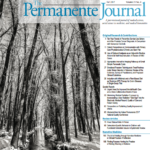Kaiser Permanente's report in NEJM AI details insights from a large-scale rollout of ambient AI clinical documentation technology.
Fall Edition of the Permanente Journal Now Available
 The latest Permanente Journal is now available for download, and includes a variety of peer-reviewed articles and studies on topics from chronic lower back pain to mental health care. This edition also includes a special report by Michael Kanter, MD, chief quality officer of The Permanente Federation; and Patrick Courneya, MD, chief medical officer of Kaiser Foundation Health Plan and Hospitals; on the critical need for academic publishing to foster continuous quality improvement. In the Journal, the two quality leaders included abstracts from the Kaiser Permanente 2017 National Quality Conference to encourage more academic publishing of quality improvement efforts.
The latest Permanente Journal is now available for download, and includes a variety of peer-reviewed articles and studies on topics from chronic lower back pain to mental health care. This edition also includes a special report by Michael Kanter, MD, chief quality officer of The Permanente Federation; and Patrick Courneya, MD, chief medical officer of Kaiser Foundation Health Plan and Hospitals; on the critical need for academic publishing to foster continuous quality improvement. In the Journal, the two quality leaders included abstracts from the Kaiser Permanente 2017 National Quality Conference to encourage more academic publishing of quality improvement efforts.
Read more about what’s inside this quarter’s Journal and click on articles of interest below. Or you can download the PDF for the complete edition.
Original Research & Contributions
![]() Ten-Year Trends in Preventive Service Use Before and After Prostate Cancer Diagnosis: A Comparison with Noncancer Controls
Ten-Year Trends in Preventive Service Use Before and After Prostate Cancer Diagnosis: A Comparison with Noncancer Controls
Lauren P Wallner, PhD, MPH; Jeffrey M Slezak, MS; Ronald K Loo, MD; Roshan Bastani, PhD; Steven J Jacobsen, MD, PhD
Men enrolled in Kaiser Permanente Southern California with newly diagnosed prostate cancer (PCa; 2002-2008) were matched 1:1 to men without a PCa diagnosis on age, race, and timing of prostate-specific antigen test (N = 31,180). The rates of preventive services were lower among men with PCa vs PCa-free men. However, in the 5 years after diagnosis, rates of preventive service use for all services were greater among PCa survivors vs PCa-free men (colorectal cancer, lipids, hemoglobin A1C, glucose, influenza vaccine, pneumococcal vaccine).
![]() Patient Perspectives on Communication with Primary Care Physicians about Chronic Low Back Pain
Patient Perspectives on Communication with Primary Care Physicians about Chronic Low Back Pain
Sarah Evers, MPH; Clarissa Hsu, PhD; Karen J Sherman, PhD, MPH; Ben Balderson, PhD; Rene Hawkes; Georgie Brewer; Anne-Marie La Porte, MA; John Yeoman, MA, MHC; Dan Cherkin, PhD
Patients with chronic low back pain (CLBP; N = 28) participated in 3 focus groups. Comments about communicating with physicians fit into themes of listening and empathy, validating pain experiences, conducting effective CLBP assessment, providing clear diagnosis and information, and collaboratively working on treatment. Patients shared that physicians can foster positive interactions with CLBP-affected patients by sharing personal experiences of chronic pain, being truthful about not having all the answers, and being clear about how patients can benefit from referrals.
![]() Use of Epidural Analgesia as an Adjunct in Elective Abdominal Wall Reconstruction: A Review of 4983 Cases
Use of Epidural Analgesia as an Adjunct in Elective Abdominal Wall Reconstruction: A Review of 4983 Cases
Efstathios Karamanos, MD; Sophie Dream, MD; Anthony Falvo, DO; Nathan Schmoekel, DO; Aamir Siddiqui, MD
All patients who underwent elective ventral hernia repair from 2005 to 2014 were retrospectively identified. Patients were divided into 2 groups by the postoperative use of epidural analgesics as an adjunct analgesic method. Of the 4983 identified patients, 237 had an epidural analgesic placed. Use of epidural analgesia was associated with significantly lower rates of 30-day presentation to the Emergency Department, but those patients had longer hospital stays and a higher incidence of complications, with no measurable positive clinical impact on pain control.
Appropriate Interval for Imaging Follow-up of Small Simple Pancreatic Cysts
Jordan Menda; Maile E Yoon; Hyo-Chun Yoon, MD, PhD
All abdominal magnetic resonance imaging (MRI) studies in a geographically isolated health maintenance organization (1/1/2012-12/31/2014) were reviewed retrospectively. Of 1946 patients, 342 had at least 1 pancreatic cyst, and 228 patients had additional imaging to determine rates of change. None of those cysts measuring 2 cm or smaller on MRI grew more than 5 mm in 2 years. Patients with cysts are more likely to have pancreatic cancer, but earlier follow-up imaging would not change their diagnosis of pancreatic cancer.
Emotional Freedom Techniques to Treat Posttraumatic Stress Disorder in Veterans: Review of the Evidence, Survey of Practitioners, and Proposed Clinical Guidelines
Dawson Church, PhD; Sheri Stern, MS, CRNP, APRN-PMH; Elizabeth Boath, PhD; Antony Stewart, FFPH, FRSPH, MPH; David Feinstein, PhD; Morgan Clond, MD, PhD (Cand)
The authors surveyed 448 emotional freedom techniques (EFT) practitioners: Most (63%) reported that even complex posttraumatic stress disorder (PTSD) can be remediated in 10 or fewer EFT sessions; 65% found that > 60% of PTSD clients are fully rehabilitated, and 89% stated that less than 10% of clients make little or no progress. The authors recommend a stepped care model with 5 EFT therapy sessions for subclinical PTSD and 10 sessions for clinical PTSD, in addition to group therapy, online self-help resources, and social support.
Induction with Infliximab and a Plant-Based Diet as First-Line (IPF) Therapy for Crohn Disease: A Single-Group Trial
Mitsuro Chiba, MD, PhD; Tsuyotoshi Tsuji, MD, PhD; Kunio Nakane, MD, PhD; Satoko Tsuda, MD; Hajime Ishii, MD, PhD; Hideo Ohno, MD; Kenta Watanabe, MD; Mai Ito, MD; Masafumi Komatsu, MD, PhD; Takeshi Sugawara, MD
Approximately 30% of patients with Crohn disease (CD) are unresponsive to biologics. No previous study has focused on a plant-based diet in an induction phase of CD treatment. A prospective single-group trial at tertiary hospitals in Japan included consecutive adults with a new diagnosis of CD (26), children with a new diagnosis (11), and relapsing adults (9) naïve to treatment with biologics. Patients were admitted and administered a standard induction therapy with infliximab and received a lacto-ovo-semivegetarian diet. The remission rates by the intention-to-treat and per-protocol analyses were 96% and 100%, respectively. Mucosal healing was achieved in 46% of cases.
Special Report
![]() Urgent Need for Improved Mental Health Care and a More Collaborative Model of Care
Urgent Need for Improved Mental Health Care and a More Collaborative Model of Care
James Lake, MD; Mason Spain Turner, MD
This article reviews challenges facing mental health care and proposes an agenda for developing a collaborative care model in primary care settings that incorporates conventional biomedical therapies and complementary and alternative medicine approaches. By moving beyond treatment delivery via telephone and secure video and providing earlier interventions through primary care clinics, Kaiser Permanente is shifting the paradigm of mental health care to a collaborative care model focusing on prevention.
Special Report
Minimizing Medical Radiation Exposure by Incorporating a New Radiation “Vital Sign” into the Electronic Medical Record: Quality of Care and Patient Safety
Jonathan Lukoff, MD, FAAP, FABPM; Jaime Olmos, ScD
There is a clearly perceived and imminent need to decrease unnecessary and detrimental exposure to medical ionizing radiation. The authors propose a new radiation “vital sign” that incorporates cumulative radiation exposure to create a risk score on the basis of an individualized assessment of potential harm from additional exposure to medical radiation. They propose to then tie the risk score to real-time, evidence-based, clinical decision support for procedures that use ionizing radiation. Additionally, the authors offer recommendations that minimize unnecessary or low-yield uses.
Special Report
Perspective on Publishing Quality Improvement Efforts
Michael Kanter, MD; Patrick T Courneya, MD
Abstracts from the Kaiser Permanente 2017 National Quality Conference
Quality improvement (QI) activities are essential to create a learning health care system. Publishing QI activities has great value, encourages greater rigor, and helps facilitate greater willingness to share improvement opportunities.
![]() Cancer Screening Reminders: Addressing the Spectrum of Patient Preferences
Cancer Screening Reminders: Addressing the Spectrum of Patient Preferences
Susan D Brandzel, MPH; Erin J Aiello Bowles, MPH; Arika Wieneke; Susan Carol Bradford, MS; Kilian Kimbel; Hongyuan Gao, MS; Diana SM Buist, PhD, MPH
The authors conducted 11 focus groups among adults recommended for cancer screening within Kaiser Permanente Washington. Most participants preferred personalized reminders, and many favored receiving reminders less than 3 months before the recommended procedure date rather than a consolidated annual reminder. Younger participants more commonly requested electronic reminders, such as texts and e-mails. Optimization of reminders enables members to request which form of reminder they prefer (eg, electronic, paper, telephone) and the timing with which they want to be reminded.
![]() Teens and Technology Transforming Acne Treatment
Teens and Technology Transforming Acne Treatment
Donna Lee Ettel, PhD; Lora Rose LaManno, MSN/ED, RN, RD; Sarah Anne Neyra; Wallace John Ettel; George Leonard Ettel, III, MMS; Matthew Kevin Mitchell
Of 497 students who completed surveys (71%), 82% believed they were using evidence-based sources when searching for health information on the internet. Skin and acne topics were researched significantly more often. Most students (80%) reported using Google as their Number 1 search engine, 38% used WebMD, 50% used Wikipedia. Most students trust health information they learn from the Internet.
![]() User-Centered Design for Developing Interventions to Improve Clinician Recommendation of Human Papillomavirus Vaccination
User-Centered Design for Developing Interventions to Improve Clinician Recommendation of Human Papillomavirus Vaccination
Michelle L Henninger, PhD; Carmit K McMullen, PhD; Alison J Firemark, MA; Allison L Naleway, PhD; Nora B Henrikson, PhD, MPH; Joseph A Turcotte
Five potential intervention strategies targeted at health care clinicians, youths, and their parents were developed, the two most popular were a values-based communication strategy and a puberty education workbook. User-centered design is a useful strategy for developing potential interventions to improve the rate and success of clinicians recommending the human papillomavirus vaccine.
![]() “It Keeps Us from Putting Drugs in Pockets”: How a Public-Private Partnership for Hospital Management May Help Curb Corruption
“It Keeps Us from Putting Drugs in Pockets”: How a Public-Private Partnership for Hospital Management May Help Curb Corruption
Taryn Vian, PhD; Nathalie McIntosh, PhD; Aria Grabowski, MPH
![]() Evaluation of a “Just-in-Time” Nurse Consultation on Bone Health: A Pilot Randomized Controlled Trial
Evaluation of a “Just-in-Time” Nurse Consultation on Bone Health: A Pilot Randomized Controlled Trial
Douglas W Roblin, PhD; David Zelman, MD; Sally Plummer, RN; Brandi E Robinson, MPH; Yiyue Lou, MS; Stephanie W Edmonds, PhD; Fredric D Wolinsky, PhD; Kenneth G Saag, MD, MS; Peter Cram, MD, MBA
Pilot randomized controlled trial for nurse consultation for osteoporosis (participants = 104) reported 52-week improvements in strengthening and weight-bearing exercise, calcium intake, osteoporosis knowledge, activation, dietary self-efficacy, and osteoporosis care satisfaction. “Just-in-time” nurse consultation yielded a few improvements over 52 weeks in osteoporosis-related outcomes; however, most changes were not different from those obtained through the lower-cost Patient Activation after DXA (dual-energy x-ray absorptiometry) Result Notification intervention or usual care.
![]() Comparing Hospital Processes and Outcomes in California Medicare Beneficiaries: Simulation Prompts Reconsideration
Comparing Hospital Processes and Outcomes in California Medicare Beneficiaries: Simulation Prompts Reconsideration
Gabriel J Escobar, MD; Jennifer M Baker, MPH, CHES; Benjamin J Turk, MAS;David Draper, PhD; Vincent Liu, MD, MS; Patricia Kipnis, PhD
This article is not a traditional research report. It describes how conducting a specific set of benchmarking analyses led the authors to broader reflections on hospital benchmarking. They compared hospital processes and outcomes among Kaiser Permanente Northern California’s (KPNC) Medicare Advantage beneficiaries and non-KPNC California Medicare beneficiaries (2009-2010). If the admission severity of illness in non-KPNC hospitals increased, KPNC hospitals’ mortality performance would appear worse; conversely, if admission severity at non-KPNC hospitals’ decreased, KPNC hospitals’ performance would appear better.
Review Articles
Knee Osteoarthritis: A Primer
Michelle J Lespasio, DNP, JD, ANP; Nicolas S Piuzzi, MD; M Elaine Husni, MD, MPH; George F Muschler, MD; AJ Guarino, PhD; Michael A Mont, MD
The purpose of this article is to provide a synopsis of the current medical understanding of knee osteoarthritis. We describe the prevalence, causes and associated risk factors, symptoms, diagnosis and classification, and treatment options. A quiz serves to assist readers in their understanding of the presented material.
Clinical Medicine
Image Diagnosis – Yellow Palms and Soles: Look Beyond the Eyes and Think Beyond Hyperbilirubinemia
Puneet Chhabra, MBBS, MD, DM; Deepak K Bhasin, MD, DM, FASGE, AGAF, FAMS
Our patient’s yellow palms and soles were attributed to diabetes mellitus. Other causes of yellow palms and soles, like carotenemia caused by ingestion of nutritional supplements, hypothyroidism, and renal and hepatic failure, were ruled out. Yellow palms and soles in patients with diabetes are caused by impaired metabolism of carotene in the liver.
Case Reports
Left Ventricular Noncompaction Cardiomyopathy and Recurrent Polymorphic Ventricular Tachycardia: A Case Report and Literature Review
Oluwaseun A Akinseye, MD, MPH; Uzoma N Ibebuogu, MD, FACC, FSCAI; Sunil K Jha, MD, MRCP, FACC, FHRS
Left ventricular noncompaction cardiomyopathy is increasingly being diagnosed because of advances in imaging modalities. It is important to differentiate this new phenotype of cardiomyopathy from others because its diagnosis, management, and prognosis differ.
Bilateral Large Pneumothoraxes Following Implantable Cardioverter-Defibrillator Generator Change: A Case Report of an Uncommon Event Complicating a Common Procedure
Ritin Bomb, MD, FACC; Sunil K Jha, MD, MRCP, FACC, FHRS
Spontaneous bilateral large pneumothoraxes occurred after placement of an implantable cardioverter defibrillator generator and lead revision without evidence of any obvious traumatic cardiac injury. Rupture of bilateral pleura during subclavian access or presence of pleuropleural communication or a right atrial microperforation could be possible causes.
Deadly Sphenoid Fungus—Isolated Sphenoid Invasive Fungal Rhinosinusitis: A Case Report
Jason E Gilde, MD; Christopher C Xiao, MD; Victoria A Epstein, MD; Jonathan Liang, MD
Acute invasive fungal rhinosinusitis (AIFRS) is a potentially fatal infection, usually affecting immunocompromised patients. Isolated sphenoid sinus involvement is rare and has been reported in only a few cases. The authors discuss the clinical characteristics, histopathologic features, and differential diagnosis of AIFRS of the sphenoid sinus, and the case of a 57-year-old man with a history of refractory non-Hodgkin lymphoma and neutropenia.
Narrative Medicine
The Art of Healing through Narrative Medicine in Clinical Practice: A Reflection
Aeman Muneeb; Hena Jawaid, MBBS, FCPS; Natasha Khalid, MBBS; Asad Mian, MD
Understanding a human body (both its physiology and pathology) along with components of emotional and spiritual cores can lead to provision of excellent medical care and better outcomes. One could infer from the evidence-based research that the practice of narrative medicine improves one’s concern toward and understanding of the patient. Medical care without compassion and humaneness causes high rates of dissatisfaction among both patients and health care practitioners. The mainstay of treatment in any domain of medicine should contain thoughtfulness for a sufferer rather than sole consideration of the suffering.
Finding Purpose: Honing the Practice of Making Meaning in Medicine
Lois Leveen, PhD
Despite decades of advances in diagnosing and treating a broad range of illnesses, many changes in our health care system impede true caregiving, leaving patients and practitioners dissatisfied and creating an emotional burden for practitioners that contributes to the staggering rates of physician burnout. This article demonstrates how group discussions of poetry can foster communication, connection, and collective reflection for physicians, interprofessional health care teams, and groups that include practitioners, patients, and families, allowing participants to once again find meaning in medicine.
Soul of the Healer
Enchanted
Sapna Reddy, MD
Mabel Dodge Luhan’s House
Usha Tatini, MD
Painted Windows
April M Day, MD
Ganoderma Applanatum
David Moiel, MD
Sunrise at Tunnel View
Jorge Ramirez, MD
On the Cover
Cathedral
Brad Christian McDowell, MD
Comic Book
Thwack
By Barry Abrams, MD
This is the story of a physician with hypertrophic cardiomyopathy being managed by an implantable cardioverter-defibrillator. In the middle of a snowstorm, he receives his first of many staggering shocks from his runaway defibrillator. Learning to live in this new reality includes learning to live with the strong magnet that blocks the defibrillator signal, much to his own chagrin and the amusement of others. (The first Graphic Medicine book.) Available at: www.permanentepress.com


